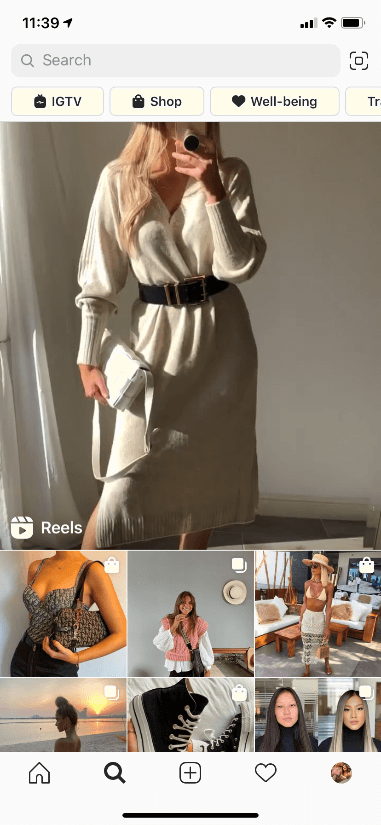As the dust settles around the newly founded Instagram ‘Reels’, we discuss definitions, developments and the general discourse to see if it could be a worthy new addition to your own social strategy.
Instagram Reels: ‘Dud’ or Diamond?
Announced a little over a month ago, Instagram coined Reels as ‘a new way to create and discover short, entertaining videos on Instagram’. The in-app feature allows you to share videos with your followers and (depending on your privacy settings) the Instagram community, through the explore page. Once the video is shared, it can then be found on a separate Reels tab on your profile, and your main profile grid.
The explore tab, which is the current home of Reels, is where you will find the latest trends on Instagram made by anyone – not just those you follow. Explore hosts a variety of different content, including regular posts, reels, videos, and shopping. You may also notice ‘featured’ content which is selected by Instagram to help you to discover original content.
Later postulates that ‘While the Reels algorithm hasn’t been locked down yet, it feels similar to the TikTok For You page. It’s likely influenced by who you already follow, what content you interact with, and where you’re located’. To give Reels a greater sense of autonomy, Instagram are currently trialling a dedicated Reel button in the control panel for Android users in India.

Reels for Brands & Businesses
Reels is an in-app feature of Instagram, meaning their 1 billion active users automatically have access to the feature, unlike competitor TikTok which is an app requiring a download. This means that users are more likely to give it a try with it being less of a commitment than a download. Businesses will find this useful as, if they already have a following on Instagram, they won’t need to build another on a different platform.
What’s more, due to Reels being on the Explore page, users who don’t follow you will see your content. This is a great exposure opportunity to gain awareness and followers for your brand.
One of the main criticisms of Instagram is that the content tends to be structured and ‘fake’. Reels poses as an opportunity to allow brands to have fun with their creative expression and show personality. An example of a brand who are already successfully embracing Reels is Louis Vuitton. The Louis Vuitton channel is already averaging on 8 million views and has stirred a stylistic trend following their recent videos.
An issue brands may encounter, is that the only analytics available at present are view count, likes and comments. This is problematic in seeing the all-important social conversion point. Vox reported that as a user one of the biggest issues is ‘Almost all the content is from blue checks’ meaning its ‘the same résumé-approved content that makes Instagram boring in the first place’.
Whereas TikTok is crammed full of creators, thus far Reels’ creative space feels dominated by the brands and influencer. This makes the space feel commercialised, contrived, and inauthentic.
Reels vs. TikTok
The New York Times labelled Instagram Reels a ‘TikTok clone’ and a ‘dud’, but to finally address the elephant in the room, how does Reels really compare to TikTok?
Starting with the points of likeness, foundationally both allow users to create, edit and share videos. From here things begin to differ – firstly – TikTok is a standalone app, whereas Reels is a feature on the Instagram app.
Whilst TikTok has the illustrious algorithm-driven ‘for you’ page, Reels’ home is currently the explore page, which the New York Times describes as ‘a mishmash of photos, sponsored posts and long-form videos’. The ‘For You’ page is also an easy way to go viral, while with Reels, your exposure is generally limited to a minimal SoV of the explore page.
Reels also lacks a space to post ‘friends only’ content, it can either be posted for the world on the explore page or your entire follower list on private accounts.

Then there’s the simplicity of TikTok, you can upload videos in bulk and the platform will create a slick compilation video in under 10 seconds. Reels is noticeably more difficult to navigate and the result doesn’t have the same smooth feel.
Another benefit of TikTok is the ability to download the videos (watermarked with the TikTok emblem) and then upload to different platforms. With Reels when you download videos, due to copyright issues, the music is stripped from the video.
Finally one of the most used features on TikTok is ‘duet’, this allows users to ‘reply to video content’ and thousands of these videos have gone viral. This is just one more feature that Reels doesn’t possess.
Is it the Reel deal?
Forbes has found that ‘Almost nine in ten TikTok users who have used Instagram Reels say that Facebook’s TikTok competitor is basically the same as TikTok’. However, due to their similarities, Forbes found that ‘61% said they’ll be spending more time in Instagram’ – and unsurprisingly since – Instagram usage is up. This shows that the similarities, despite being obvious, could be beneficial in attracting users to a recognisable format.
Lest we forget the rise of Instagram Stories, once known as the Snapchat clone, it now dominates the ‘story’ scene. This proves Instagram’s ability to take an idea, build on it, and break their audience into it.
Also, a small reminder that Reels is in its infancy, a mere month and a half into its life, Instagram has plenty of time to amend and adapt the app to make it as streamlined as TikTok. Take the trial of the Reels button in India, this would solve the explore page issues discussed previously.
Perhaps Reels won’t be the new TikTok. But that doesn’t change the fact that as a feature, it could add a lot to your brand. Reels presents itself as less of a risk than TikTok, more of a means to have fun and continue to be supported by your fan base.
Take this opportunity to engage a different mass audience – those who prefer quick content that’s easy to digest — and do it quickly, before the market becomes over-saturated.
If you found this update useful, check out our latest blog posts for the latest news, and if you’re interested in finding out more about what we can do for your brand, get in touch with the team today.





